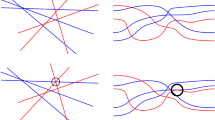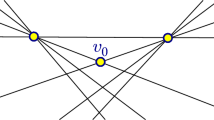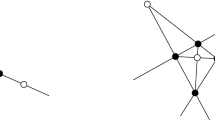Abstract
A weaving W is a simple arrangement of lines (or line segments) in the plane together with a binary relation specifying which line is “above” the other. An m by n bipartite weaving consists of m horizontal and n vertical lines or line segments which mutually intersect. A system of lines (or line segments) in 3-space is called a realization of W, if its projection into the plane is W and the relative positions of the lines respect the “above” specifications. An equivalence class of weavings induced by the combinatorial equivalence of the underlying planar arrangement of lines is said to be a weaving pattern. A weaving pattern is realizable if at least one element of the equivalence class has a realization. A weaving (pattern) W is called perfect, if along each line of W, the lines intersecting it are alternately “above” and “below”. We prove that (i) a perfect weaving pattern of n lines is realizable if and only if n≤3, (ii) a perfect m by n bipartite weaving pattern is realizable if and only if min(m, n)≤3, (iii) if n is sufficiently large then almost all weaving patterns of n lines are nonrealizable.
Supported in part by Hungarian NFSR grant 1812, NSF grant CCR-8901484 and the Center for Discrete Mathematics and Theoretical Computer Science (DIMACS), a National Science Foundation Science and Technology Center, under NSF grant STC88-09648.
Supported in part by NSA grant MDA904-89-H-2030, NSF grants DMS-85-01947 and CCR-8901484, and DIMACS.
Supported in part by the ESPRIT II Basic Research Actions Program of the EC under contract no. 3075 (project ALCOM) and DIMACS
Preview
Unable to display preview. Download preview PDF.
Similar content being viewed by others
References
B. Chazelle, H. Edelsbrunner, L.J. Guibas and M. Sharir, Lines in space — combinatorics, algorithms and applications, Proc. 21st Ann. ACM Sympos. Theory Comput. (1989), 382–393.
B. Chazelle, H. Edelsbrunner, L.J. Guibas, R. Pollack, R. Seidel, M. Sharir and J. Snoeyink, Counting and cutting cycles of lines and line segments in space (in preparation).
H. Edelsbrunner, Algorithms in Combinatorial Geometry. Springer-Verlag, Heidelberg, Germany, 1987.
H. Edelsbrunner, L.J. Guibas, J. Pach, R. Pollack, R. Seidel and M. Sharir, Arrangements of curves in the plane — Topology, Combinatorics and Algorithms, Proc. 15th Int. Colloq. on Automata, Languages and Programming (1988), 214–229.
B. Grünbaum, Arrangements and Spreads, Reg. Conf. Series in Math. AMS, Providence, 1972.
J.E. Goodman and R. Pollack, Semispaces of configurations, cell-complexes of arrangements, J. Comb. Theory, Ser. A 37, 1984, 257–293.
H. Edelsbrunner, L.J. Guibas and M. Sharir, The complexity and construction of many faces in arrangements of lines and of segments, Discrete and Comp. Geom., 5, 1990, 161–196.
J. Milnor, On the Betti numbers of real varieties, Proc. Amer. Math. Soc., 15 (1964), 275–280.
M. McKenna and J. O'Rourke, Arrangements of lines in 3-space: A data structure with Applications, Proc. 4th Symp. on Computational Geometry (1988), 371–380.
R. Penne, On line diagrams, (manuscript, 1989).
R. Penne, Algorithms for line diagrams, (manuscript, 1989).
R. Thom, Sur l'homologie des varietes algebriques reelles. Differential and Combinatorial Topology, Ed. S.S. Cairns (Princeton University Press, 1965).
O.Ya. Viro, Topological problems concerning lines and points of three-dimensional space, Soviet Math. Dokl. 32 (1985), 528–531.
H.E. Warren, Lower bounds for approximation by linear manifolds, Trans. Amer. Math. Soc. 133 (1968), 167–178.
W. Whiteley, Weaving lines and tensegrity frameworks, (manuscript, 1988).
W. Whiteley, Weaving and lifting plane line configurations, (manuscript, 1988).
Author information
Authors and Affiliations
Editor information
Rights and permissions
Copyright information
© 1990 Springer-Verlag Berlin Heidelberg
About this paper
Cite this paper
Pach, J., Pollack, R., Welzl, E. (1990). Weaving patterns of lines and line segments in space. In: Asano, T., Ibaraki, T., Imai, H., Nishizeki, T. (eds) Algorithms. SIGAL 1990. Lecture Notes in Computer Science, vol 450. Springer, Berlin, Heidelberg. https://doi.org/10.1007/3-540-52921-7_93
Download citation
DOI: https://doi.org/10.1007/3-540-52921-7_93
Published:
Publisher Name: Springer, Berlin, Heidelberg
Print ISBN: 978-3-540-52921-7
Online ISBN: 978-3-540-47177-6
eBook Packages: Springer Book Archive




